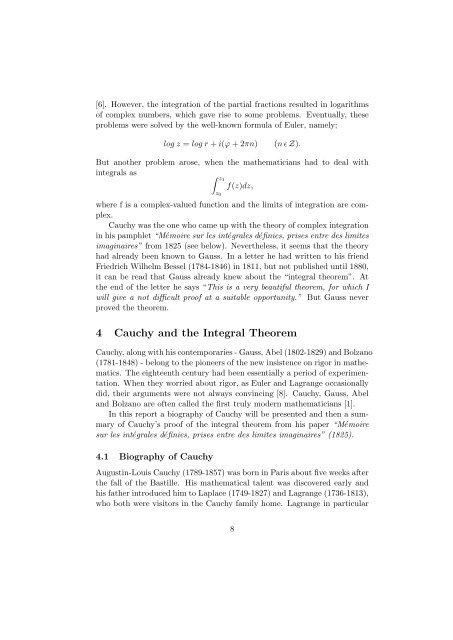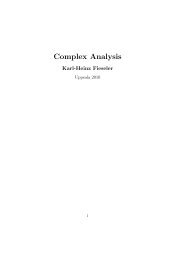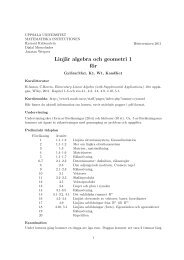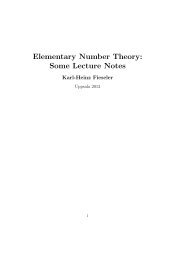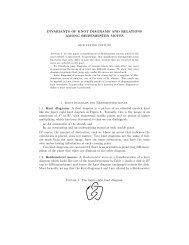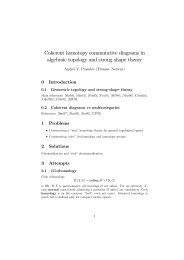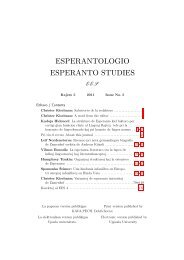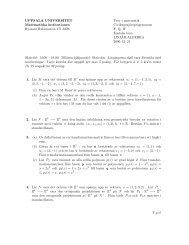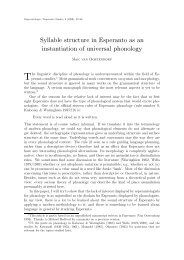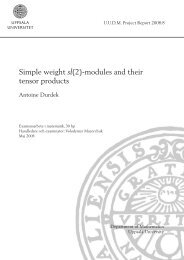Malmsten's Proof of the Integral Theorem
Malmsten's Proof of the Integral Theorem
Malmsten's Proof of the Integral Theorem
- No tags were found...
You also want an ePaper? Increase the reach of your titles
YUMPU automatically turns print PDFs into web optimized ePapers that Google loves.
[6]. However, <strong>the</strong> integration <strong>of</strong> <strong>the</strong> partial fractions resulted in logarithms<strong>of</strong> complex numbers, which gave rise to some problems. Eventually, <strong>the</strong>seproblems were solved by <strong>the</strong> well-known formula <strong>of</strong> Euler, namely;log z = log r + i(ϕ + 2πn)(n ɛ Z).But ano<strong>the</strong>r problem arose, when <strong>the</strong> ma<strong>the</strong>maticians had to deal withintegrals as∫ z1f(z)dz,z 0where f is a complex-valued function and <strong>the</strong> limits <strong>of</strong> integration are complex.Cauchy was <strong>the</strong> one who came up with <strong>the</strong> <strong>the</strong>ory <strong>of</strong> complex integrationin his pamphlet “Mémoire sur les intégrales définies, prises entre des limitesimaginaires” from 1825 (see below). Never<strong>the</strong>less, it seems that <strong>the</strong> <strong>the</strong>oryhad already been known to Gauss. In a letter he had written to his friendFriedrich Wilhelm Bessel (1784-1846) in 1811, but not published until 1880,it can be read that Gauss already knew about <strong>the</strong> “integral <strong>the</strong>orem”. At<strong>the</strong> end <strong>of</strong> <strong>the</strong> letter he says “This is a very beautiful <strong>the</strong>orem, for which Iwill give a not difficult pro<strong>of</strong> at a suitable opportunity.” But Gauss neverproved <strong>the</strong> <strong>the</strong>orem.4 Cauchy and <strong>the</strong> <strong>Integral</strong> <strong>Theorem</strong>Cauchy, along with his contemporaries - Gauss, Abel (1802-1829) and Bolzano(1781-1848) - belong to <strong>the</strong> pioneers <strong>of</strong> <strong>the</strong> new insistence on rigor in ma<strong>the</strong>matics.The eighteenth century had been essentially a period <strong>of</strong> experimentation.When <strong>the</strong>y worried about rigor, as Euler and Lagrange occasionallydid, <strong>the</strong>ir arguments were not always convincing [8]. Cauchy, Gauss, Abeland Bolzano are <strong>of</strong>ten called <strong>the</strong> first truly modern ma<strong>the</strong>maticians [1].In this report a biography <strong>of</strong> Cauchy will be presented and <strong>the</strong>n a summary<strong>of</strong> Cauchy’s pro<strong>of</strong> <strong>of</strong> <strong>the</strong> integral <strong>the</strong>orem from his paper “Mémoiresur les intégrales définies, prises entre des limites imaginaires” (1825).4.1 Biography <strong>of</strong> CauchyAugustin-Louis Cauchy (1789-1857) was born in Paris about five weeks after<strong>the</strong> fall <strong>of</strong> <strong>the</strong> Bastille. His ma<strong>the</strong>matical talent was discovered early andhis fa<strong>the</strong>r introduced him to Laplace (1749-1827) and Lagrange (1736-1813),who both were visitors in <strong>the</strong> Cauchy family home. Lagrange in particular8


